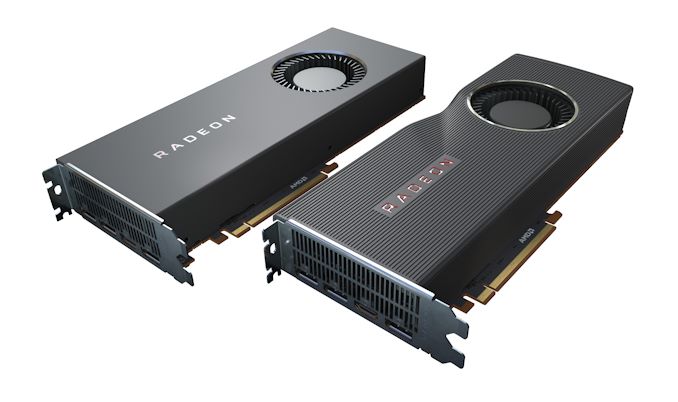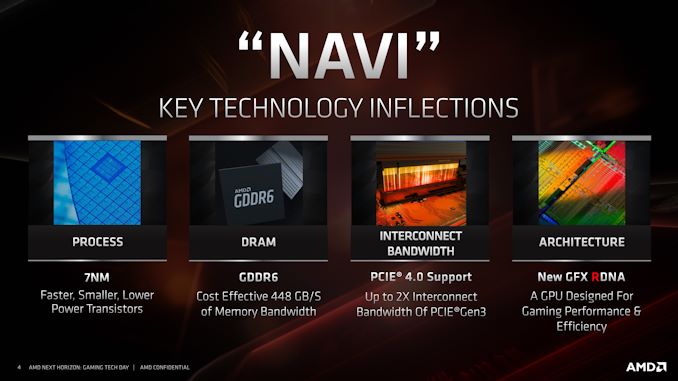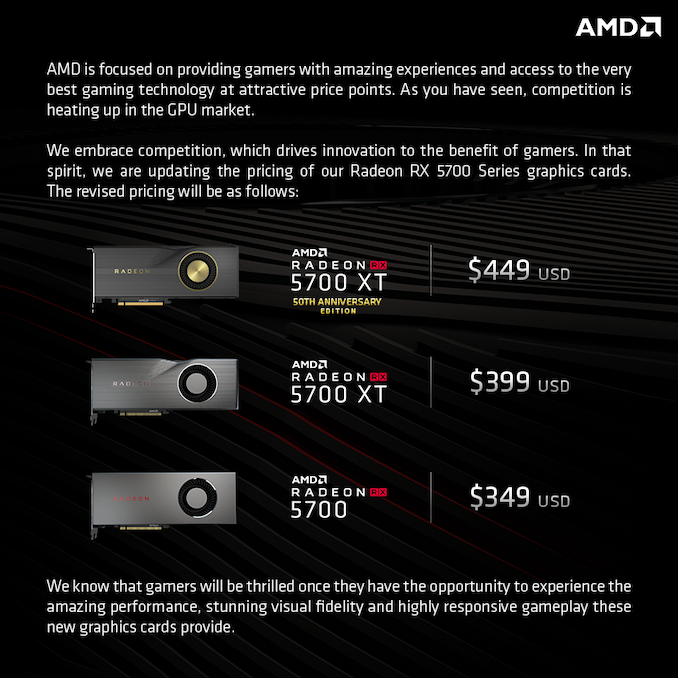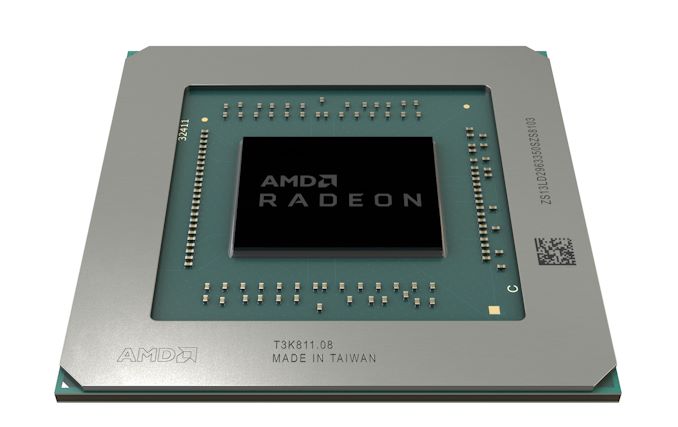The AMD Radeon RX 5700 XT & RX 5700 Review: Navi Renews Competition in the Midrange Market
by Ryan Smith on July 7, 2019 12:00 PM EST
There have been teasers, press conferences, architectural announcements, and pricing games all around – and all before the first card has even shipped. The run-up to the launch of AMD’s new Radeon RX 5700 series of video cards has been a dynamic and memorable time, and a very fitting outcome for a family of cards named after AMD’s legendary Radeon HD 5700 series. However, at some point all the showmanship must come to an end and the cards will fall where they may: launch day is upon us for AMD’s Radeon RX 5700 series and RDNA GPU architecture.
I’m not sure there’s anything traditional about an AMD video card launch at this point, but today’s launch is about as non-traditional as they come, right on down to the Sunday launch date. AMD announced their video cards almost a month ago at an epic (ed: that’s EPYC) E3 event, taking the wraps off of both their new CPUs and GPUs. Rather than hold anything back, AMD came to E3 with everything front-loaded: specifications, prices, architectural details; everything except a pile of cards to sell. So we’ve been waiting for this moment for some time now, to test AMD’s claims about power, performance, and features, and see how they translate into real-world gaming performance. AMD has a lot that they want to do in the video card space, and riding high on their success with Zen the company’s ambition is once again palpable.
Getting down to business then, today is the launch of AMD’s next generation of video cards, the Radeon RX 5700 series. Aimed at what these days is the midrange segment of the video card market, AMD is looking to carve out a new place for the company in the hearts of gamers who are looking for high performance video cards that won’t break the bank. These parts are, in turn, based on AMD’s Navi 10 GPU, which is the first GPU using the company’s new RDNA architecture. And, while Navi 10 is not AMD’s first 7nm GPU – an honor the Radeon VII and its Vega 20 beat it to – it’s the first 7nm GPU that you’re actually going to want to pay attention to.
Altogether, AMD is rolling out two(ish) cards today. At $399 we have AMD’s new class-leading Radeon RX 5700 XT, which is a full-fledged Navi 10 card with all the trimmings. Meanwhile, for the slightly more budget conscious, we have the $349 Radeon RX 5700 (vanilla), a cut-down Navi 10 card that gives up some performance for lower pricing and lower power consumption. Finally, AMD is also launching their own “Anniversary Edition” version of the 5700 XT, which features a factory overclock and will sell for $449. (This card will be a footnote for today’s article, as it’s a limited-edition card that AMD isn’t sampling)
| AMD Radeon RX Series Specification Comparison | ||||||
| AMD Radeon RX 5700 XT | AMD Radeon RX 5700 | AMD Radeon RX 590 | AMD Radeon RX 570 | |||
| Stream Processors | 2560 (40 CUs) |
2304 (36 CUs) |
2304 (36 CUs) |
2048 (32 CUs) |
||
| Texture Units | 160 | 144 | 144 | 128 | ||
| ROPs | 64 | 64 | 32 | 32 | ||
| Base Clock | 1605MHz | 1465MHz | 1469MHz | 1168MHz | ||
| Game Clock | 1755MHz | 1625MHz | N/A | N/A | ||
| Boost Clock | 1905MHz | 1725MHz | 1545MHz | 1244MHz | ||
| Throughput (FP32) | 9.75 TFLOPs | 7.95 TFLOPs | 7.1 TFLOPs | 5.1 TFLOPs | ||
| Memory Clock | 14 Gbps GDDR6 | 14 Gbps GDDR6 | 8 Gbps GDDR5 | 7 Gbps GDDR5 | ||
| Memory Bus Width | 256-bit | 256-bit | 256-bit | 256-bit | ||
| VRAM | 8GB | 8GB | 8GB | 4GB | ||
| Transistor Count | 10.3B | 10.3B | 5.7B | 5.7B | ||
| Typical Board Power | 225W | 180W | 225W | 150W | ||
| Manufacturing Process | TSMC 7nm | TSMC 7nm | GloFo/Samsung 12nm | GloFo 14nm | ||
| Architecture | RDNA (1) | RDNA (1) | GCN 4 | GCN 4 | ||
| GPU | Navi 10 | Navi 10 | Polaris 30 | Polaris 10 | ||
| Launch Date | 07/07/2019 | 07/07/2019 | 11/15/2018 | 08/04/2016 | ||
| Launch Price | $399 | $349 | $279 | $179 | ||
For both gamers and AMD, the launch of the RX 5700 is an important one – and likely to be the most significant video card launch of the year. For consumers, this is the first series of high-volume video cards built on a 7nm process, pushing performance up and prices down at a time where video card pricing has been sluggish improve. For AMD, this launch gets their incredibly important RDNA architecture out the door to its first users, all the while renewing their competitiveness in the midrange market. The RX 5700 series aren’t flagship-level cards, but make no mistake: for AMD they’re still as important as any flagship launch.
AMD’s Radeon DNA (RDNA) architecture, in turn, is an interesting development. We’ll get into much greater detail later on, but at a high level RDNA is the most significant architectural development for AMD since the launch of Graphics Core Next in 2011. AMD and its engineers have made changes to their GPU architecture at some of its most fundamental levels, which comes with significant ramifications for performance, efficiency, and more. This is all to prepare their next-generation architecture for the company’s grand goals: RDNA and its successors will be in PC video cards, in APUs, in game consoles, and thanks to a partnership with Samsung, even in mobile GPUs.
Still, RDNA is only as valuable as the performance it brings, and this will especially be the case for the RX 5700 series. The first iteration of this architecture is all about changing the internal plumbing of AMD’s GPUs. As a result, there are no real marquee hardware features to speak of – AMD isn’t rolling out paradigm-changing features like ray tracing or the next Rapid Packed Math – so for consumers, the RX 5700 cards are essentially interchangeable with 2017’s Vega cards in terms of graphics functionality. Which is not to say that AMD is showing up empty-handed, but what new features it is rolling out – Radeon Anti-Lag and Radeon Image Sharpening – are software-based features that will be available to the entire Radeon product family. This means that the payoff for AMD needs to be in pricing, power consumption, and performance; the RX 5700 needs to deliver on the fundamentals.
Ultimately there are a lot of words I could spill on the subject of AMD, especially on today of all days, the launch of both their next-generation CPU and GPU architectures. But perhaps it’s best to keep things simple: today’s launch of the company’s Radeon RX 5700 series video cards and the RDNA architecture is a much-needed opportunity for the company to reset and recover in the video card space. Vega was ultimately underwhelming, Polaris is very long in the tooth, and AMD is still feeling the hangover from the cryptocurrency boom & busts. The company has held on to their consumer market share through aggressive pricing – RX 500 series cards are disruptively cheap – but AMD needs to be more visible and more profitable if they want to remain a viable competitor to juggernaut NVIDIA. Not to mention shoring up their position as Intel ramps up to become the third player in the video card space in the next couple of years.
Product Positioning, Availability & the Competition
Leading up to today’s launch, the announcement Radeon RX 5700 series has created quite a butterfly effect across the greater video card industry. With AMD having shown their cards early, NVIDIA, who has essentially been dominating the $300+ space since the start of the year, made their own preemptive move with the launch of the GeForce RTX 2070 Super and the RTX 2060 Super. A price cut in everything but name, the new Super cards saw NVIDIA essentially shift the performance of its $699 RTX 2080 and $499 RTX 2070 cards down to $499 and $399 respectively. These cards won’t go on sale for another two days (on a more traditional Tuesday), but it’s a launch that was clearly intended to shore up NVIDIA’s own position while taking some steam out of AMD’s launch.
AMD in turn made their own adjustments, cutting the price of their cards on Friday before they even launched. While the RX 5700 XT was originally set to launch at $449 and the RX 5700 (vanilla) at $379, these became $399 and $349 cards respectively before the first board was ever sold. These kinds of last-minute pricing shenanigans are not unheard of – first impressions count for a lot – however it’s been a long time since we’ve seen AMD and NVIDIA trading shots in quite such a direct manner. The net result is that, at least for the $349 to $499 segment of the video card market, the performance-per-dollar ratio just went up even more.
Overall, outside of today’s unusual launch date, this should be a pretty standard launch cycle for AMD. The company is launching with reference cards first, meaning that AMD and board partners alike will be selling cards based on AMD’s reference PCB and blower. Custom and semi-custom cards will come later, as supplies ramp up, board partners qualify their coolers, and new, GDDR6-capable PCBs are engineered. AMD has not disclosed how many cards are being distributed for the launch, but these days it’s rare to see a new generation of midrange (or better) cards not sell out at launch. So anyone interested in an RX 5700 card may need to act quickly.
Within AMD’s product stack, these new cards will be the backbone of AMD’s product lineup. The company’s Vega family of cards was already on its way out due to competition from NVIDIA, so this will be the final push for those cards. That will leave the Radeon VII above the RX 5700 cards, and then the RX 500 series below it. And while AMD hasn’t announced any other Navi GPUs, sooner or later those cards will get pushed out too by a lower-tier Navi GPU.
Trickier, perhaps, is placing the new cards within a historical context for AMD’s product lineups. Is the Radeon RX 5700 series the successor to the RX Vega series, or the RX 500 series? In terms of pricing and absolute performance, it’s closer to the former. However in terms of die size and relative performance gains, these cards feel a lot like the next-generation successors to Polaris. It’s a bit of an academic question – buyers are going to focus on perf-per-dollar first and foremost – but how these cards are framed will have an impact on how they’re received.
Sizing up the competition, AMD was originally going to launch these cards against NVIDIA’s GeForce RTX 2070 and RTX 2060. Now with the launch of the Super cards and the impending retirement of the RTX 2070, those matchups have changed. NVIDIA’s competition is now the RTX 2060 Super at $399, and the RTX 2060 (vanilla) at $349, both prices directly opposite AMD’s new cards. AMD in turn comes in with the edge on manufacturing process, as they’re using TSMC 7nm versus the 16nm offshoot that NVIDIA uses, however NVIDIA comes in with a notable feature advantage thanks to ray tracing and variable rate shading support. AMD and NVIDIA’s cards are not equal in features, and that will play a big part in their value.
Ultimately, today’s launch isn’t a case of a next-generation card coming in and wiping the floor with its last-generation competition; like the RTX 20 series launch last year, the RX 5700 launch is a more gradual shift in pricing and performance. GPU development is expensive, 7nm is even more expensive, and everyone is playing things a lot more conservatively than they did earlier this decade. For the moment then, the RX 5700 series can largely be considered to be part of the same generation of GPUs as the RTX 20/GTX 16 series, for all of the benefits and downsides that entails. The upside is that we get more to talk about, and get to form a more nuanced opinion, but for anyone looking for a simple recommendation for a new video card, there won’t be anything quite that simple with this launch.
Finally, both AMD and NVIDIA will be looking to tip the scales with game bundles. On the AMD side, the company is launching both its new CPUs and GPUs with their new Xbox Game Pass for PC bundle, which will see the products come with a 3-month voucher for Microsoft’s new game subscription service. Meanwhile NVIDIA is bundling Wolfenstein: Youngblood with its RTX 2060, while the new RTX 2060 Super and RTX 2070 Super cards get that plus Control as well.
| July 2019 GPU Pricing Comparison | |||||
| AMD | Price | NVIDIA | |||
| Radeon VII | $699 | GeForce RTX 2080 Super | |||
| $499 | GeForce RTX 2070 Super | ||||
| Radeon RX 5700 XT | $399 | GeForce RTX 2060 Super | |||
| Radeon RX 5700 | $349 | GeForce RTX 2060 | |||














135 Comments
View All Comments
Ryan Smith - Sunday, July 7, 2019 - link
Hey all,As you've probably noticed, this review is a bit bare-bones on information outside of benchmarks. With 2 video card launches in the span of a week - not to mention AMD's very important CPU launch - I've been stretched a bit thin trying to get everything to fall into place.
So with the basics done and all of the benchmarks processed, I'm posting this now to let you all see how the RX 5700 series did on our testbench, and what my impressions are of the card. After getting some much-needed sleep, I'll be working on fleshing out the article some tonight, and then later in the week after I return from a further trip. I have 15 pages of notes on everything from threads to video decoding, and I want to get to it all.
Icehawk - Sunday, July 7, 2019 - link
I know there is Bench and only so much space but considering who the target market is (you even specify in the conclusion) it would have been nice to see a 970 and a 580 in graphs. I’m still thinking it’s wait another generation though as my 970 handles 1440p on most games and I want the full jump to 4k from my next card - especially if it’s going to run north of $350.0ldman79 - Sunday, July 7, 2019 - link
Agreed.I've got a 960M, a GTX 970 in one machine and 970 SLI in another.
I'm just now starting to look hard at the newer cards. Direct comparisons would be appreciated, however, direct comparisons are already found on the Bench.
Surfacround - Monday, July 15, 2019 - link
sorry, but dump the gtx970 SLI, and get a super2060, or a gtx1660ti... or an AMD card, nvidia needs to have a ZERO graphic cards sales period for a year, so they realize that they have it be in the GPU making business, not the sell-overpriced-GPU-business...nvidia needs to sell its rtx2070,2080 cars at half price... because the new consoles are going be as fast or faster than a gtx1660ti... (same speed as a 5700 my guess, or effectively that speed... for AMD it is moot, if you buy the new console in two years, or their graphics card... NVIDIA still loses.
Ryan Smith - Sunday, July 7, 2019 - link
Just so it's noted, a 580 is in the graphs (it's in blue). As for a 970, with half of AT's video cards on the other side of the country right now, I couldn't swing one. But I do have a 980 in there.just4U - Sunday, July 7, 2019 - link
I think I would have preferred to see the last generation king included (1080ti) but other than that there's some great reference points overall to compare to.yankeeDDL - Monday, July 8, 2019 - link
If I may: in general, it's great to see the new cards stacked against their direct competitors, however, for people looking to upgrade, it's almost always more interesting to be able to look back at 2, 3, even 4 generations.The benchmarks of the RX400 and RX300, with latest drivers and modern titles, don't exist, so it's difficult to compare them against the new breeds.
Obviously, everyone expects the new ones to be considerably faster, however, the question is "is it worth it"?
Example: I have a Ryzen 5 1600 and I wonder if I should upgrade to the 3600x. More cores, higher clock, same power: for sure it is faster, but does it really make a difference?
jabber - Monday, July 8, 2019 - link
They always forget to include the previous 2-3 generations which are in fact the cards 85% of us 'normal' folks looking for a midrange upgrade have. We only get to see how they compare with cards from 6 months previous.Just a note...some of us sweat our hardware for 2-4 years...cos we have to.
BikeDude - Monday, July 8, 2019 - link
"some of us sweat our hardware for 2-4 years...cos we have to."No, we are not cheap, but "environmentally conscious". ;)
jabber - Monday, July 8, 2019 - link
That and some of us just don't waste our lives running benchmarks all day."Mmmm man that $650 got me an extra 3FPS!"